Chrysler Valiant News
_0.jpg)
Goodbye to our last cheap V8: Chrysler Australia's biggest hits and misses over its nearly 60-year history
Read the article
By Byron Mathioudakis · 21 Nov 2021
Chrysler has exited Australia again, along with the 300 sedan that was the sole torch bearer for the 96-year-old brand as well as this country’s last affordable V8 muscle car.
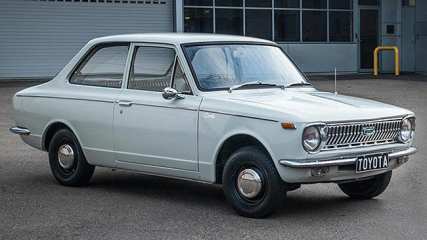
Toyota Corolla is universal
Read the article
By Paul Gover · 19 Sep 2013
How can they not, when the Japanese hero is now the world's all-time favourite with a production total that has just topped 40 million cars. Based on those numbers, the Corolla is nearly twice as popular as the Volkswagen Beetle with 21.5 million sales and even further ahead of the T-Model Ford at 16.5 million, although it has had the advantage of selling at a time when far more people everywhere in the world own and drive cars.My first experience of the Corolla was in the 1960s, soon after the original cars landed in Australia. By the standard of the times, and we're talking here about Falcons and Kingswoods and Valiants, it was tiny and tinny but also solid, sensible and smartly priced. I was only a rider and not a driver at the time, but it also had a fun factor that was missing from other cars of my acquaintance - and you have to remember that an Austin Freeway cringed in our suburban Sydney driveway.The original Corolla helped ignite a small-car revolution and laid the firm foundation that now sees Toyota rampaging along as Australia's favourite carmaker, with annual sales that trump the combined efforts of Holden and Mazda in the other podium places.In America, the Corolla - along with the Honda Civic - is credited with the relatively recent bankruptcy of General Motors and Chrysler. Looking back to the USA in the sixties, it became the 'second' car in many American households and won over women and youngsters driving for the first time. They went Japanese and never came back. Does that sound familiar?Since the late 1970s I've driven every new Corolla model and had some fantastic fun on the side, including flat-out track laps in pursuit of an Australian racing championship and several forest fights in the Australian Rally Championship. And a Corolla has never let me down.And that gets me thinking about the Honda 750 four. You see, the Honda stalwart from the seventies was tagged as the Universal Japanese Motorcycle because it could do anything, from high-speed pursuit duties with the Highway Patrol police to daily commutes to touring the world in the days before long-distance motorcyclists switched to BMWs.In the same way, the Corolla should be known as the Universal Japanese Car. It's as sensible as an accountant, as dependable as a bullet train, and as predictable as a new tech toy from Apple. It's also a bankable investment on the secondhand scene and will never offend or annoy. It doesn't have the attitude of an Alfa, or the performance of a Porsche, but a UJC is just fine and we have 40 million signatures to prove it.This reporter is on Twitter: @PaulWardGover
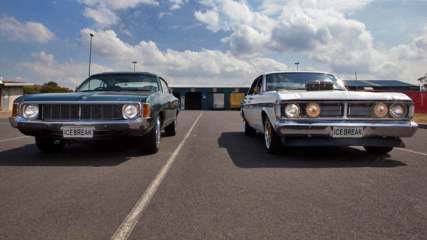
Guitar vs drums in drag race
Read the article
By CarsGuide team · 13 Nov 2012
Bands bicker over what holds tracks together: guitars or drums. We find out which rules a different kind of track. The coffee-heads over at Ice Break thought a drag race was the only way to settle the deep-rooted guitars vs drums battle for supremacy.Facebook fans were along for the ride and helped customise two classic Australian muscle cars to represent the two camps – and which will be the prizes in a coming competition. The guitarists were championed by a 1973 VJ E44 Valiant Charger 318 V8, modified to take two in-built Marshall amps in place of the back seats, a custom guitar holder in the trunk, a wah-wah pedal accelerator and a colour-shifting Harlequin paint finish.Drummers were represented by a 1970 XY Ford GT Replica 351 V8, with a snare drum air intake built into the bonnet, a Zildjian cymbal steering wheel, a fully adjustable drum hardware roll cage, and a bass drum beater gear shift.Sydney’s Eastern Creek Dragway was the battleground, with the winner supposedly settling once and for all who holds the track. Aussie muscle car fans have the chance to win the two cars – plus two more that will fight a future battle. Log on to Facebook/com/icebreak for more details.
-wide.jpg)
My 1965 Valiant "GT" 4 door Fastback
Read the article
By David Burrell · 19 Jun 2012
Rather than advertise, he decided to build an attention getting car, which would show off his skills.In America the Plymouth Barracuda had just been released. They were a two door version of the Plymouth Barracuda, with a huge and distinctive back window which wrapped over the rear half of the car.Tony figured that importing a Barracuda and converting it to right hand drive was too costly for his budget. But good old Aussie inventiveness won the day. Tony decided to build a 4 door Barracuda, using a local Valiant as a base.A 1964 Valiant, with rear end damage , was bought from a wrecker for only $900. "I employed a friend of mine, Graham Hurst, to do the body work. The mangled rear panels behind the rear doors were removed and the sub frame was straightened. Graham hand crafted new rear mudguards from 20 gauge steel", Tony told us."The boot lid and fastback roof panels were also hand fabricated then welded in place and the seams lead wiped for a flush finish". "We then finished it all off with ten coats of Tartan Red paint, the same colour used on the MGB."The tinted rear window was the most complex part of the process. It was made from perspex. To get the right shape, Tony had moulds made in fibreglass .These were used to shape the perspex. This was done by G&S Motor Bodies in Carlton NSW at a cost of $120.The interior was the show piece for Tony's business. The front boasted fully adjustable bucket seats from a Porsche. The rear seat cushion was redesigned so that it would fold flush to the floor, like a station wagon. All the door trims and seats were covered in black doe hide.The headlining and sun visors were black perforated vinyl .Black plush carpet was used throughout. Tony says the Valiant GT Fastback was often mistaken for a Plymouth Barracuda. The car was an absolute stunner and featured in local car magazines, including Australian Hot Rodding. So, just where is this car now? Well, Tony does not know. He sold it and it has passed into the mists of time. Maybe it is still out there, somewhere? Mind you, Tony does know where another car he built went. In 1970 he was one of the first to insert a V8 in the then new Ford Capri. A guy named Jack Brabham bought that one.
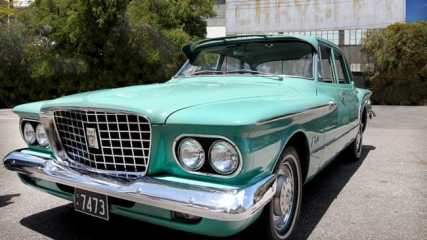
Chrysler Valiant turns 50
Read the article
By David Burrell · 29 Mar 2012
It is 50 years since Chrysler sold its first Valiant in Australia.Based on the American Plymouth it went into the market place with bold styling and big power from its six cylinder engine. The styling of the Valiant was the work Chrysler's head of design, Virgil Exner. He was determined to create something which stood out in the "small" (for the USA) car class. And he succeeded. Contemporary motoring magazine reports usually described it as "European".Exner even applied for, and was granted, a US patent for the styling of the Valiant. It is design number 190,533 and dated 5th July 1961, if you are interested.For Australian car buyers the styling was only one distinctive aspect of the car. It offered automatic transmission, with gears selected via a space age looking push buttons located on the right hand side of the instrument cluster.Those with extra cash could order a heart, with its press button controls on the left side. And to make it complete, the radio was a push button "Moparmatic Deluxe", slotted into the centre of the dashboard. Mercury astronauts had less buttons to push than the driver of a 1962 Valiant.The front suspension was by torsion bars, and it gave the Valiant a big American car ride, so the advertisements claimed. But it was the 3.7 litre motor, pumping out 108kw, compared to Holden anaemic 60kw, which really captured everyone's attention.Back in the day, the Valiant was one fast car. It had a top speed of nearly 160km/h and did the 400metres in a little over 19 seconds. Just as importantly, the extra power and torque of the engine meant you could now easily tow a boat or caravan with locally built car, rather than having to buy a very much more expensive Chevrolet, Chrysler Royal or Ford Fairlane.By the end of the first year, Chrysler has sold over 11,000 Valiants, winning sales mostly from Holden The early Valiants are sought-after classics today, though in the early 1970s they could be had for a little as $250. I know, because I almost bought one as my first car.I purchased a 1961 Vauxhall Cresta instead, for $200. These days a good quality Valiant can be had for $12000 to $15,000, while ones need a little TLC go for between $5000 and $7000.As a first time classic car, these Valiants are ideal, because the motor and gearbox are just about unbreakable and body, trim and interior parts are easy to come by in Australia and the USA.David Burrell is the editor of www.retroautos.com.au

My 1971 VG Valiant
Read the article
By David Burrell · 12 Feb 2012
When your computer spits the dummy Mark fixes it So what car would you expect this technology guru to drive every day? A 1971 VG Valiant four door sedan, that's what. But not any Valiant.This one is a base model, with a basic 215 cubic inch hemi six. It has a three speed automatic, a radio and is stopped by drum brakes. There is no power assistance of any kind.The VG is a genuine one family car. "It was my grandmother's car. She won it in an Art Union lottery. She only bought one ticket," explains Mark.So not only is the Valiant a bare bones basic piece of transport, it cost almost nothing. Mark continues the story: "My grandmother drove it for about 20 years and when she gave up driving at age 85 it was given to me".Nothing has been done to the Valiant during its forty years on the road, save for the usual servicing and replacement of worn parts. The motor and auto transmission are original. The interior is original, too. The front seat shows some signs of wear but the back seat gleams as if new.Although the body has a few rust spots, the paint work may be fading in a few places and the chrome a little tarnished, Mark's VG is a perfect example of classic car motoring in its purest form. Cheap, reliable transport that has been cared for but not pampered.And it is rare. How many stock standard VG Valiants with the smallest of the hemi sixes have you seen recently?Any automobile that has survived with its original motor intact, its interior in useable condition and the paint work still presentable renders it very desirable and collectible.In the USA and the UK there values of original cars are climbing at a faster rate than restored collectibles. They are considered to be irreplaceable time capsules. "Worn in, not worn out", is a sound bite starting to gain traction.(pic left: The 215 cubic inch 'hemi' engine.)VG HistoryReleased in March 1970 the VG Valiant was little changed from its VF predecessor, at least in the styling department. The VF was itself a mild facelift of the VE, which was an Australianised version of the 1966 American Dodge Dart.By contrast it was the engine which got all the attention. Gone was the reliable `slant' six, and in its place was a trio of `hemi' sixes.These motors allowed Chrysler to keep its bragging rights for having the most powerful six cylinder engines of the big three in Australia.To ensure we all were aware of the hemi , Chrysler brought a retired Stirling Moss out to Australia to front their comprehensive advertising campaign.VE, VF and VG Valiant's are very much underrated as classic cars.The two door hardtops have never reached the money levels of the Monaro, despite their Dodge Dart heritage and cool, clean looks. Consequently they represent great value for those looking for stylish and reliable classic cars. Buy now and avoid the rush. The distinctive concave rear window was an enduring design feature of the VE, VF and VG modelsDavid Burrell is editor of www.retroautos.com.au
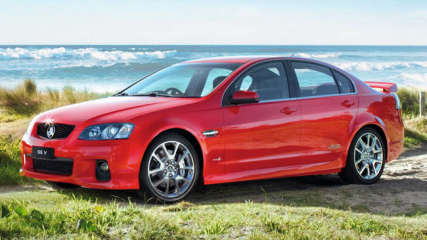
V8 cars are special
Read the article
By Mark Hinchliffe · 14 Jul 2011
Even at a time when fuel economy is top-of-mind with a growing number of Australian drivers there is plenty of space on the roads for Commodores and Falcons with old-fashioned V8 muscle under the bonnet. They burble menacingly at idle. They are the backbone of V8 Supercar racing.Yet V8s in the 21st century are not what they were in the days when they first conquered Mount Panorama and a GTHO Falcon or a Monaro - or even a Valiant V8 - was a dream machine for a generation of Aussie youngsters.Since 1970 the crude oil price has exploded from $20 a barrel to double that amount during the Iran revolution, over $70 during the first Gulf War, broke through the $100 barrier ahead of the Global Financial Crisis and has now settled at just below $100.In Australia, petrol prices have correspondingly risen from about 8c a litre in 1970 to about 50c in 1984 and almost $1.50 today.Despite all this, and despite one attempt at a death sentence by Ford in the 1980s, the V8 has not been wiped from Australian showrooms. Holden and Ford have continued to produce large cars with a V8 alternative and continue to slog it out at Bathurst.But Australian cars, even the ones that now have American V8s imported for local use, are not the only bent-eight blasters on the road.Germans are prolific builders of V8s and produce some of the most powerful engines in the world thanks to AMG-Mercedes, BMW and Audi. English V8s are built by Aston Martin, Land Rover and Jaguar, while the Americans provide V8s in the Chrysler 300C sold here. Even the Japanese luxury brand Lexus has a V8 in its IS F hero and its luxury saloon LS460, as well as the LandCruiser-cloned LX470.Most V8s are powerful enough breathing ordinary air, but there are many forced-induction models with either turbo or supercharging to liberate even more power. Walkinshaw Performance does the job in Australia for Holden, BMW is going down the turbo V8 road for its latest M cars and Benz had a time with a supercharged AMG V8.But V8s are not just about unrestricted power. The push for greater fuel economy has also reached V8 land and so Chrysler and Holden have V8s with multiple displacement technology which shuts down half the cylinders when the car is just cruising to improve fuel economy. Formula One racing engines now do the same thing when they are idling on a grand prix starting grid.Holden's Active Fuel Management (AFM) was introduced on the V8 Commodore and Caprice in 2008 and the red lion brand is committed to the engine - with future technology updates - despite near-record fuel prices."It is incumbent on us to keep it relevant and continue introducing new technology that delivers on our customers' needs," says Holden's Shayna Welsh.Holden has the biggest stake in V8s with more models than any other company selling in Australia. It has a total of 12 models with V8 engines across four nameplates and four body styles, including Commodore SS, SS V, Calais V, Caprice V and the recently introduced Redline range. V8s account for about one quarter of Commodore sedan sales and almost half of Ute sales."We see it as being more than just the V8 engine - it's about the entire car. It's the whole performance package that appeals to people and we want to continue making cars that people are proud to own," Welsh says."The combination of features and technology, great handling and braking and outstanding value is consistent across our V8 model range."Ford fans are also committed to V8s, according to company spokesperson Sinead McAlary, who says a recent Facebook survey was overwhelmingly positive."We asked whether they worry about petrol prices and they say 'No, it's the sound of the V8 we love and we are prepared to pay the price'," she says.Both Ford and Holden also have performance divisions where the V8 was, and still is, king. Ford's is Ford Performance Vehicles (FPV) and Holden's is Holden Special Vehicles (HSV).HSV marketing manager Tim Jackson says their sales are "on par" with last year."That's despite the fact that last year we had the limited edition GX-P which is an entry level product for us," he says. "We don't have that model in our range at all this year and you would expect numbers to come off, but we've been able to maintain sales volume."All of HSV's range are powered by a naturally aspirated V8 engine (6200cc 317kW-325kW), while the opposition at FPV has gained the kilowatt advantage with forced induction (supercharged 5000cc 315kW-335kW).Jackson says their LS3 V8 has been "validated" by customers."We're not getting guys screaming at us to go turbocharging. The LS3 is an extraordinary unit. It's a light engine with a good power-to-weight figure. There is not a turbo engine that would do it for us at the right development cost. But I wouldn't rule it (turbo) out or rule it in."Jackson says there have been no repercussions from the rise in petrol prices."Our customers don't have other choices in their repertoire," he says. "A small car doesn't suit them and they're not into an SUV. They're of a certain level where the whole cost of running the car is easy for them to absorb."The top-selling HSV is the ClubSport R8, followed by the Maloo R8, then GTS.However, the greatest HSV in history is debatable, Jackson says.HSV engineering boss Joel Stoddart prefers the all-wheel-drive Coupe4 and sales boss Darren Bowler the SV5000."The Coupe4 is special because of its engineering but I like the W427 because it's the fastest," Jackson says.FPV boss Rod Barrett says they are also experiencing strong sales growth. He says they sold about 500 cars in the first quarter, which is up 32 per cent on the previous year. He also says sales of the F6 have slowed since the launch of the supercharged V8 engine variants late last year, as customers "opt for power". Ford no longer offers a V8 with the demise of the XR8 sedan and ute last year."Our middle name is performance so we have all the V8s," Barrett says. "When we were launching this new supercharged car all the V8s came across here."Barrett says their supercharged engine has changed people's minds about "dinosaur V8s"."The turbocharged F6 was a cult hero car in its day and people thought a V8 was a low-tech dinosaur," he says. "But when we produced a high-tech all-alloy five-litre supercharged V8 built in Australia people started to think that V8s aren't all that bad after all. I'm not seeing the demise of the V8 just yet, but for us, the future is hi-tech."The supercharged 5.0Litre V8 335kW FPV GT continues to be FPV's top-selling vehicle followed closely by the supercharged V8 5.0 litre 315kW GS sedan and GS ute.Barrett believes the current GT is the best FPV car yet with its segment-leading power, light weight and improved fuel economy."However, I think our most iconic car was the 2007 BF Mk II 302kW Cobra in white with blue stripes. That car brought back the passion of '78 with the original Cobra. If you have a look at the second-hand prices, they are still holding up very well" he says.

My Chrysler Valiant Charger
Read the article
By Stuart Martin · 14 Apr 2011
The Lonsdale engine plant might be unrecognisable and Tonsley Park has little signage left, but there's plenty of examples of Chrysler's production history still running hard. The Chrysler Charger legend was born in 1971 and for years was the fastest-accelerating Australian-built car.
Tony and Karen Lennell have strong connections to the breed, with family working for the company at the time of the Charger's production. But it wasn't always Chryslers that sat in the Lennell garage - Holdens and later HSVs were under the the roof as well.
"I was a Holden man but had family ties to Chrysler here - Karen's dad was an engineer there, they've grown on me over the years so we decided to buy one," he says. The couple - under the pretence of a weekend away in Sydney - found what they were looking for just over a year ago at Australian Musclecar Sales in Sydney.
The couple's car is a pretty rare beast - a 1971 three-speed manual VH E37 Charger R/T, powered by the famous 265-cubic inch (about 4.3-litre) in-line "Hemi" six-cylinder engine. When it left the factory in 1971 priced at $3935 new, there was 248 horsepower on offer - 185kW and 415Nm - thanks to triple Weber carburettors.
It's one of only 135 R/Ts built and one of just 18 painted in the hot mustard colour - while Mr Lennell was coy about how much he paid for the car, pristine examples have sold for as much as $100,000. "We flew to Sydney for a weekend away, and I happened to just say that we were going to stop off and look at a car - four hours later we owned the car," he says.
The E37 has been returned to factory-spec after the long and expensive task of sourcing parts and getting the car to the right automotive people for the serious work. Friday nights have become known as shed night with work continuing into early hours of Saturday morning. "We got to work on researching the original parts and equipment, it needed a three-speed gearbox, Mark at Brighton Service Centre put that in for me - he sourced the gearbox for me."
Mr Lennell said the floor, interior trim and the cabin have been returned to how the car was as it left the line at Tonsley Park 40 years ago. "The engine and diff have been given the once-over as well, the 3.23:1 LSD is back in there, it's got new original-spec extractors and the triple carburettors have been put back to rights by West Torrens Dyno Centre," he says.
Although registered on historic plates, the E37 isn't a molly-coddled museum piece - the Lennells drove it to Renmark for an award-winning appearance at a recent club event and more recently braved locusts and native fauna to enter the car in the Chrysler on The Murray event at Albury-Wodonga. "We were just at Chrysler On The Murray, where we won the best VH Charger .... we were one of more than 150 Chargers up there for the 40th anniversary," he says.
The couple received plenty of "Hey Charger" salutes on the trip to Albury-Wodonga. "Every time we stopped for fuel it took about half an hour to leave as people wanted to have a look at the car, it hardly used any oil and cruised at 100km/h all the way. "We were driving down the Hume with Leo Geoghegan's car next to us, E49s, E38s - they got a group shot of 150 of these cars together, it was fantastic."
The job is not done yet as the couple have plans to pull the engine out for another re-build - as well as a taking it back to its original colour - re-painting the engine bay and re-building the front suspension in preparation for next year.
"It was a fun drive and we're going to do it again next year - we're going to take it up to Bathurst next year and take it up The Mountain," he says.
About the Chrysler Valiant Charger
The Chrysler Valiant Charger is an icon of Australian motor vehicle manufacturing and the VH started it all. The company started manufacturing in 1971 and built 17,918 VH Chargers - at one stage accounting for half of the total Valiant production by Chrysler.
Overall, around 1300 were R/T models, and of these, but R/T E37 Performance models numbered only 135.
The R/T had a 3.23:1 differential (rather than the 2.92 standard in other Chargers), as well as a tachometer, oil pressure gauge, six-inch rims, a front anti-roll bar and a three-speed manual gearbox.
At the time the company claimed a stock E37 could complete a quarter-mile sprint in 15.7 seconds, but that number fell if the optional "six-pack" package was added, which put three two-barrel Weber carburettors on the straight-six engine and upped the power to 248hp (a 30hp increase) and 306 foot pounds.
The base-model car was priced from $2795 but the R/T was priced $3395 - now these cars can fetch anywhere between $60,000 and $110,000.
The R/T high performance pack came about from a desire to go motor racing, adding black stripes, a black radiator grille, driving lights, model-specific steel wheels, a sports instrumentation pack and a two-spoke aluminium steering wheel.
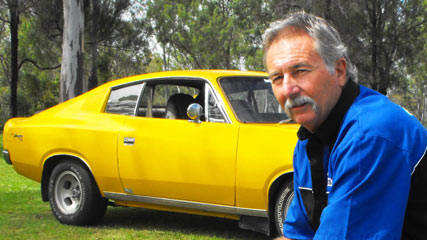
My 1973 Valiant VJ Charger
Read the article
By Mark Hinchliffe · 22 Apr 2010
Retired smelter worker Roger Graber, 62, bought his 1973 Valiant VJ Charger 15 years ago for $2000. "It's worth about $30,000-$35,000 now to an enthusiast," he says. "I wouldn't get rid of it, though. My son and grandson will probably fight over it when I fall off the perch." However, the money-making tale ends there."I did have three of these," he says. "One was a drag (racing) project with a Ford 351 engine in it and the other was stripped down. When I moved I didn't have anywhere to put them so I sold them. I only got $2500 for the drag car and $1500 for the stripper. I regret getting rid of them now."When Graber bought his current Charger it was in "a terrible state", the 265 (4.3-litre) Hemi six-cylinder engine was "knackered" and the car had been off the road for years. "I spent about two years restoring it for the road, not as a show car," he says. "It cost about $5000 for the restoration."Graber claims to be a self-taught mechanic and did all the mechanical, paint and body work on the car. "I'm mechanically minded and can turn my hands to anything," he says. "I rebuilt the engine myself to make sure it was right."However, he put in a non-standard 600 Holly carburettor. "Otherwise the engine is standard," he says. "It has heaps of grunt without having to do much to them. If I checked the economy I wouldn't drive it so much. It gets about five kilometres to the litre (20 litres per 100km) because the carby is too big for it. I have a 350 which I'll put in it and then I might get about 7km/L (14.2L/100km)."Graber totally renovated the front suspension right down to the rubbers, but has done nothing to the rear except replace the brake shoes. The car features a four-speed Borg Warner gearbox with synchro in all but first. "You can't break them and it's as smooth as," he says. "It's 1970s driving. You have to be careful because the back can break out easily.""It's hard to drive, there's so much power you can easily spin the wheels. You have to drive it smoothly. But it's very reliable. I always keep a good check on the engine and recently changed the engine oil, gearbox oil and back axle oil so it's running really smooth now."If it stays in good condition, Graber plans to show it at the MotorMania show and shine at Rockhampton Showgrounds on July 25. The show is part of a 10-day Central Queensland MotorMania festival of motoring that includes cars, karts, drag racers, motorcycles and more."There's a big concentration of petrolheads up here, maybe because it's an industrial town and people have a bit of money," he says. "Our club (Curtis Coast Cruiser Club) has more than 60 members. A lot have joined because they can get concessional rego and it's a lot cheaper, especially for the guys with V8s."
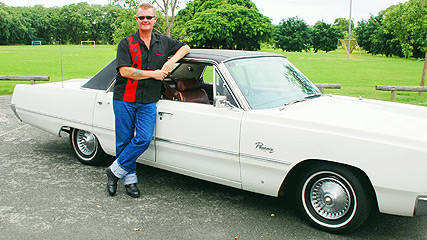
My 1967 Valiant VC Regal
Read the article
By Mark Hinchliffe · 08 Mar 2010
And somehow it all makes good sense. The 45-year-old came to Australia in 1982 when he was 17 to play in our pubs chasing the success of Aussie pub bands Australian Crawl, Men at Work and Mental as Anything."I came out here and joined a rockabilly band in Sydney," he says. "I've earned my living playing music full time ever since."Wilshire also trained as a mechanic, so when the opportunity to "earn some good money" came up maintaining the massive dragline excavators in the North Queensland mine fields, he jumped at it. "I only work three days a week up here and then fly back to Brisbane where I can continue to play my music. "When I get more money up here, I'll be able to whack a great big huge donk in the Valiant."This jumble of jobs and passions seems to fit like a jigsaw puzzle for Wilshire. His day begins at 3am when he starts a 12-hour shift keeping the big excavators running '24/7'. And he's been working on some of the biggest of them all."Dragline 37 at Peak Downs is the largest in the southern hemisphere," he says. "It weighs a couple of million pounds (about 900 tonne) and the bucket alone holds over 1500 cubic metres which is the equivalent of a house. It runs on a 66,000 volt electric motor and plugs into a giant wire about 8 inches (20cm) across."His love of big machinery extends to his passion for Chryslers. "I bought the Valiant off a guy who worked for Compass airlines and when they went bust he had to sell," he says. "He had done some of the work on it; air shocks, turquoise paint and 1970s Jelly Bean mag wheels. "The car picked me. I had to have it."The car is a 1967 Chrysler Valiant VC Regal powered by a 225 (3.6-litre) six-cylinder Hemi with a single-barrel Carter RBS downdraft carburettor."If I could get my hands on a Special I would. The Regal is the one below," he says. "I got it for just $1500 in 2006. It was a bargain. It only had 6000 miles (9656km) on the clock. I've redone the trim on the doors, rebuilt the carby, put new valve seats in as it was blowing some smoke, and a bigger exhaust. "I put 225mm tyres on the back and 190s on the front. When I pump up the air shocks the back looks high like a '60s Mopar muscle car. One day I'll put a 360 (5.9-litre) Hemi in it. It's got the engine bay big enough for it."Wilshire likes old Chryslers because they have "more style than any Ford or Holden". "My dad was a Ford man and my brother was GM man, but not me. "You can always tell a Chrysler product. Even their PT Cruiser and 300C. They have that retro style that I like. "My dream car is an AP1 or AP2 1957-59 Chrysler Royal. I'm looking for one right now. They have the biggest fins in Australia. "Fins should make a comeback."The fins, the retro car ... It all seems to fit with Wilshire's music and his sense of style. "The way I look - tattoos, clothes - it's all retro," he says. "I've been into it since grade 3 when I saw Sha Na Na. They played at Woodstock and I looked at them and I just clicked with that era."Wilshire followed rockabilly band the Stray Cats in the '80s and became good friends with guitarist Brian Setzer, recently playing support in Brisbane on the Stray Cats reunion tour. "He's one of the main reasons I wanted to play guitar. I even have a big Stray Cats tat on my left shoulder."Wilshire will launches his new solo "rockabilly, roots and blues, and western swing" album, Cuz Of You, with his band the Tailspinners at the 18th annual Brisbane Blues Festival on March 13 at the Jubilee Hotel in Fortitude Valley.Wilshire's music should even score him cheap rego. "I might put this on concessional rego and just use it for club meets. I play a lot of car club gigs, so I can use it a fair bit legally," he says.Visit: www.brisbanebluesfestival.com.





